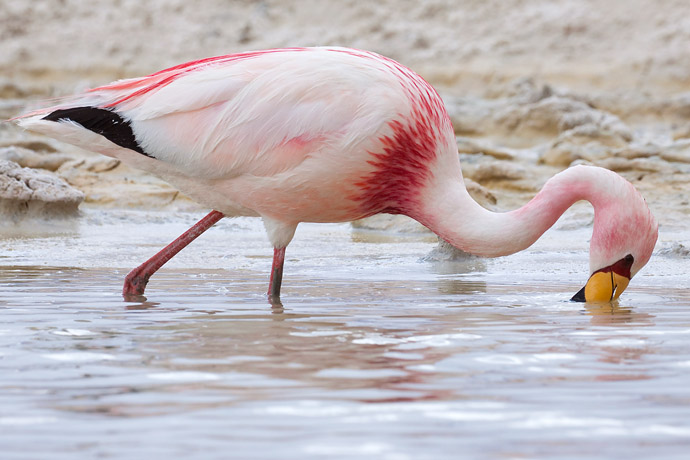Puna flamingo
(Phoenicoparrus jamesi)

Description
The James's flamingo (Phoenicoparrus jamesi),also known as the puna flamingo,is a species of flamingo that populates the high altitudes of Andean plateaus of Peru,Chile,Bolivia and Argentina.It is named for Harry Berkeley James,a British naturalist who studied the bird.James's flamingo is closely related to the Andean flamingo,and the two make up the genus Phoenicoparrus.The Chilean flamingo,Andean flamingo and James's flamingo are all sympatric,and all live in colonies (including shared nesting areas).The James's flamingo was thought to have been extinct until a remote population was discovered in 1956.James's flamingo is smaller than the Andean flamingo,and is about the same size as the Old World species,the lesser flamingo.A specimen of the bird was first collected by Charles Rahmer who was on a collecting expedition sponsored by Harry Berkley James after whom the bird was named.It measures about 90–92 centimetres (2 ft 11 in–3 ft 0 in) long on average and weighs about 2 kilograms (4.4 lb).The James's flamingo have a very long neck that is made up of 19 long cervical vertebrae allowing for a lot of movement and rotation of the head.Their long thin legs also characterize them.The knee is not visible externally but is located at the top of the leg.The joint at the middle of the leg,which most assume to be the knee joint is actually the ankle joint.Its plumage is very pale pink,with bright carmine streaks around the neck and on the back.When perched a small amount of black can be seen in the wings,these are the flight feathers.There is bright red skin around the eyes,which are yellow in adults.The legs are brick red and the bill is bright yellow with a black tip.James's flamingo is similar to other South American flamingos,but the Chilean flamingo is pinker,with a longer bill without yellow,and the Andean flamingo is larger with more black in the wings and bill,and yellow legs.The easiest method to distinguish James's flamingos is by the lighter feathers and the bright yellow on the bill.A good method to distinguish Phoenicoparrus from the other species is to look at the feet.In the other three species of flamingos the feet consist of three forward-facing toes and a hallux.The two species of Phoenicoparrus have the three toes but do not have a hallux.
Taxonomic tree:







